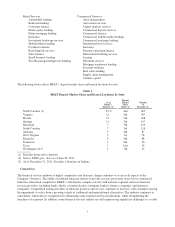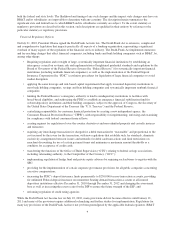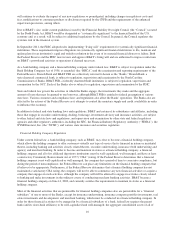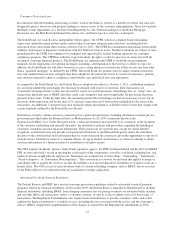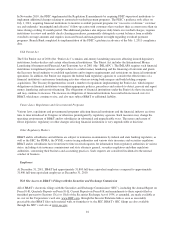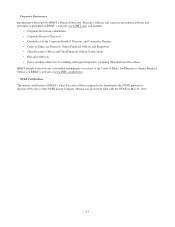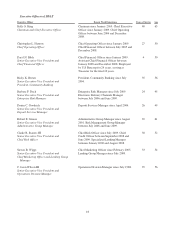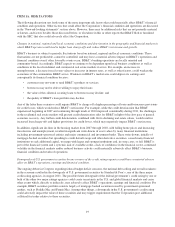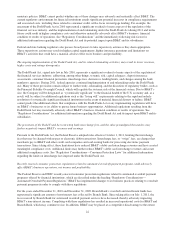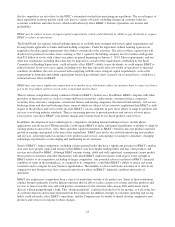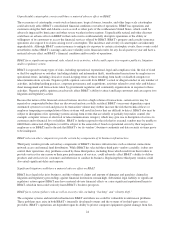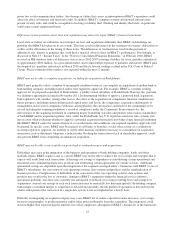BB&T 2011 Annual Report Download - page 15
Download and view the complete annual report
Please find page 15 of the 2011 BB&T annual report below. You can navigate through the pages in the report by either clicking on the pages listed below, or by using the keyword search tool below to find specific information within the annual report.Consumer Protection Laws
In connection with their lending and leasing activities, each of the Banks is subject to a number of federal and state laws
designed to protect borrowers and promote lending to various sectors of the economy and population. These laws include
the Equal Credit Opportunity Act, the Fair Credit Reporting Act, the Truth in Lending Act, the Home Mortgage
Disclosure Act, the Real Estate Settlement Procedures Act, and their respective state law counterparts.
The Dodd-Frank Act created a new, independent federal agency, the CFPB, which was granted broad rulemaking,
supervisory and enforcement powers under various federal consumer financial protection laws, including the laws
referenced above and certain other statutes, effective July 21, 2011. The CFPB has examination and primary enforcement
authority with respect to depository institutions with $10 billion or more in assets. Smaller institutions are subject to rules
promulgated by the CFPB, but continue to be examined and supervised by federal banking regulators for consumer
compliance purposes. The CFPB has authority to prevent unfair, deceptive or abusive practices in connection with the
offering of consumer financial products. The Dodd-Frank Act authorizes the CFPB to establish certain minimum
standards for the origination of residential mortgages including a determination of the borrower’s ability to repay. In
addition, the Dodd-Frank Act will allow borrowers to raise certain defenses to foreclosure if they receive any loan other
than a “qualified mortgage” as defined by the CFPB. The Dodd-Frank Act permits states to adopt consumer protection
laws and standards that are more stringent than those adopted at the federal level and, in certain circumstances, permits
state attorneys general to enforce compliance with both the state and federal laws and regulations.
As required by the Dodd-Frank Act, the Federal Reserve adopted rules effective October 1, 2011, establishing standards
for assessing whether the interchange fees that may be charged with respect to electronic debit transactions are
“reasonable and proportional” to the costs incurred by issuers for such transactions. Interchange fees, or “swipe” fees, are
charges that merchants pay to BB&T and other credit card companies and card-issuing banks for processing electronic
payment transactions. Under the final rules, the maximum permissible interchange fee that an issuer may receive for an
electronic debit transaction will be the sum of 21 cents per transaction and 5 basis points multiplied by the value of the
transaction. An additional 1 cent per transaction fraud prevention adjustment is available to those issuers that comply with
certain standards outlined by the Federal Reserve Board.
Federal law currently contains extensive customer privacy protection provisions, including substantial customer privacy
protections provided under the Financial Services Modernization Act of 1999 (commonly known as the
Gramm-Leach-Bliley Act). Under these provisions, a financial institution must provide to its customers, at the inception
of the customer relationship and annually thereafter, the institution’s policies and procedures regarding the handling of
customers’ nonpublic personal financial information. These provisions also provide that, except for certain limited
exceptions, an institution may not provide such personal information to unaffiliated third parties unless the institution
discloses to the customer that such information may be so provided and the customer is given the opportunity to opt out of
such disclosure. Federal law makes it a criminal offense, except in limited circumstances, to obtain or attempt to obtain
customer information of a financial nature by fraudulent or deceptive means.
The CRA requires the Banks’ primary federal bank regulatory agency, the FDIC for Branch Bank and the OCC for BB&T
FSB, to assess the bank’s record in meeting the credit needs of the communities served by each Bank, including low- and
moderate-income neighborhoods and persons. Institutions are assigned one of four ratings: “Outstanding,” “Satisfactory,”
“Needs to Improve” or “Substantial Noncompliance.” This assessment is reviewed for any bank that applies to merge or
consolidate with or acquire the assets or assume the liabilities of an insured depository institution, or to open or relocate a
branch office. The CRA record of each subsidiary bank of a financial holding company, such as BB&T, also is assessed
by the Federal Reserve in connection with any acquisition or merger application.
Automated Overdraft Payment Regulation
The Federal Reserve and FDIC have enacted consumer protection regulations related to automated overdraft payment
programs offered by financial institutions. In November 2009, the Federal Reserve amended its Regulation E to prohibit
financial institutions, including BB&T, from charging consumers fees for paying overdrafts on automated teller machine
and one-time debit card transactions, unless a consumer consents, or opts in, to the overdraft service for those types of
transactions. The Regulation E amendments also require financial institutions to provide consumers with a notice that
explains the financial institution’s overdraft services, including the fees associated with the service and the consumer’s
choices. BB&T completed its implementation of the changes as required by the Regulation E amendments in 2010.
15




